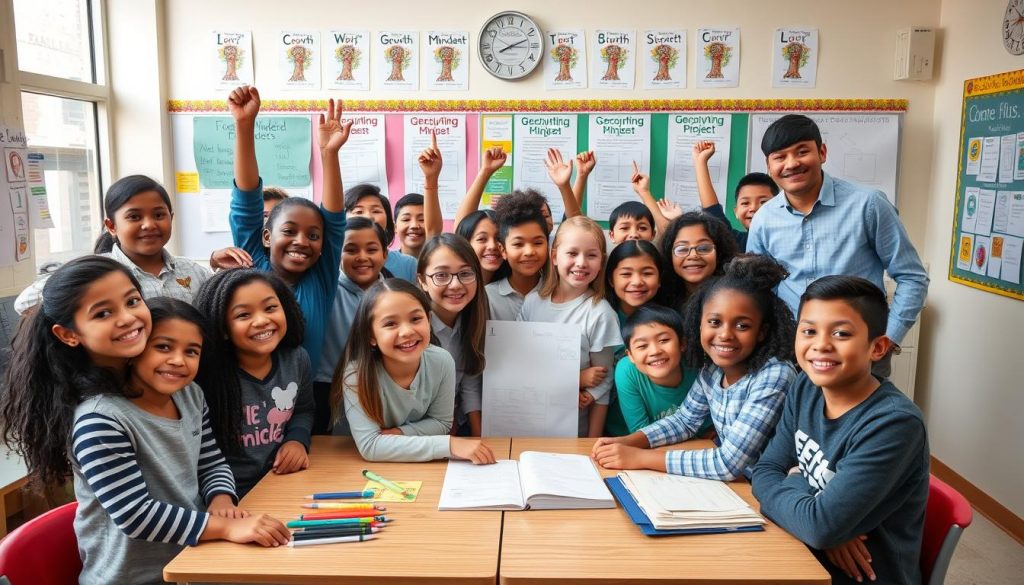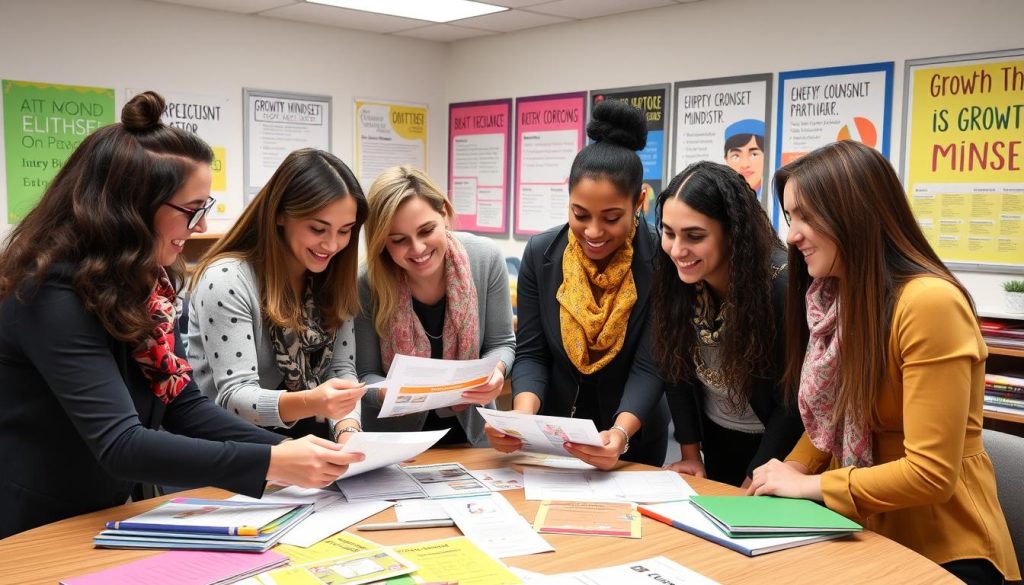Understanding Growth Mindset: The Core Concept
At its heart, a growth mindset is the belief that abilities can be developed through dedication and hard work. This view creates a love of learning and resilience essential for great accomplishment. Developing these teacher skills allows us to foster environments where students believe their talents and intelligence can be cultivated over time.
Growth Mindset Believes:
- Intelligence can be developed
- Challenges are opportunities to grow
- Effort is the path to mastery
- Feedback is constructive, not personal
- Others’ success offers inspiration
- Persistence leads to achievement
Fixed Mindset Believes:
- Intelligence is static and unchangeable
- Challenges should be avoided
- Effort is fruitless if you lack ability
- Feedback is a personal criticism
- Others’ success is threatening
- Setbacks define your identity
According to research from Stanford University, students with a growth mindset show greater motivation in school, better grades, and higher test scores. As teachers, understanding growth mindset concepts allows us to create classroom environments that nurture this powerful approach to learning.
The Science Behind Understanding Growth Mindset
The concept of growth mindset isn’t just motivational psychology—it’s grounded in neuroscience. When we understand how the brain physically changes through learning, we can better develop our teacher skills to support this natural process.
Neuroplasticity: The Brain’s Ability to Change
Our brains form new neural connections throughout life—a process called neuroplasticity. When students learn something new, their brains physically change. Understanding growth mindset means recognizing that the brain is like a muscle that gets stronger with use. Teaching students about neuroplasticity can be a powerful way to help them develop a growth mindset.
“The passion for stretching yourself and sticking to it, even when it’s not going well, is the hallmark of the growth mindset. This is the mindset that allows people to thrive during some of the most challenging times in their lives.”
Research from the Organization for Economic Cooperation and Development has found a clear link between having a growth mindset and higher student test scores and greater student well-being. This scientific backing gives teachers confidence that developing these teacher skills will have measurable impacts on student outcomes.
Practical Ways of Understanding Growth Mindset in the Classroom
Moving from theory to practice is where many teachers need support. Implementing growth mindset principles requires specific teacher skills that can be developed over time. Here are practical strategies you can use immediately:

The Power of “Yet”
One simple but powerful teacher skill is adding the word “yet” to statements about student abilities. When a student says, “I’m not good at math,” guide them to say, “I’m not good at math yet.” This small linguistic shift reinforces that abilities develop over time.
Process Praise vs. Person Praise
The way we praise students significantly impacts their mindset development. Focus on praising effort, strategies, and progress rather than intelligence or talent:
| Instead of… | Try… |
| “You’re so smart!” | “I like how you tried different strategies until you found one that worked!” |
| “You’re a natural artist!” | “I noticed how much time and effort you put into your drawing.” |
| “You got an A without even studying!” | “Your consistent work in class really paid off on this test.” |
Developing these teacher skills helps students connect their efforts to their outcomes, a key component of growth mindset thinking.
Ready to Transform Your Classroom?
Discover comprehensive resources for implementing growth mindset strategies in your K12 classroom. Our specialized materials help you develop essential teacher skills for fostering resilience and achievement.
Understanding Growth Mindset Starts with Teachers
Before we can effectively foster growth mindset in our students, we must examine our own mindsets. Teachers with growth mindsets create more supportive learning environments and have higher expectations for all students.
Self-Assessment: Your Mindset as an Educator
Consider how you respond to these scenarios:
Growth mindset response: “I’ll reflect on what didn’t work and try a different approach tomorrow.”
Fixed mindset response: “Some concepts are just too difficult for these students to grasp.”
Growth mindset response: “It might be challenging at first, but with practice, I’ll get better.”
Fixed mindset response: “I’m not tech-savvy, so these new systems will always be difficult for me.”
Growth mindset response: “Every student can improve with the right support and strategies.”
Fixed mindset response: “Some students just aren’t cut out for certain subjects.”
Developing your teacher skills includes cultivating your own growth mindset. When you model this thinking for your students, you create a more authentic learning environment.
Professional development focused on understanding growth mindset can help you refine these important teacher skills. Credits for Teachers offers resources specifically designed to help educators develop their growth mindset approach.
The Language of Understanding Growth Mindset
The words we use in the classroom have tremendous power. Developing teacher skills around growth-oriented language can shift how students perceive challenges and their own abilities.
Growth Mindset Phrases for Teachers
For Challenges
- “This may take some time and effort.”
- “Let’s break this down into steps.”
- “What strategies could we try?”
For Mistakes
- “Mistakes show us where to grow.”
- “Let’s learn from this and try again.”
- “That’s interesting—what made you think that?”
For Persistence
- “I notice your hard work is paying off.”
- “You didn’t give up when it got tough!”
- “Your persistence is impressive.”
These language patterns are essential teacher skills that reinforce growth mindset thinking. By consistently using these phrases, you create a classroom culture where effort and improvement are valued.
Quick Tip: Create a “Growth Mindset Language” poster for your classroom. Involve students in generating phrases that help them persist through challenges.
Understanding growth mindset language patterns takes practice. Many teachers find that professional development resources help them integrate these patterns more naturally into their teaching. Credits for Teachers offers specialized training in growth mindset language strategies.
Assessment and Feedback: Critical Elements in Understanding Growth Mindset
How we assess student work and provide feedback are among the most important teacher skills for fostering growth mindset. Traditional grading can sometimes reinforce fixed mindset thinking, but there are alternatives that better support growth.

Growth-Oriented Assessment Strategies
- Emphasize learning goals over performance goals
- Use rubrics that value process and improvement
- Provide opportunities for revision and reflection
- Implement portfolio assessment to show growth over time
- Use formative assessment to guide instruction
Effective Feedback Techniques
The way we deliver feedback is a crucial teacher skill for supporting growth mindset. Effective feedback is:
Specific
“Your explanation of photosynthesis shows you understand the role of chlorophyll” rather than “Good job!”
Process-focused
“The strategy you used to solve this equation was very effective” rather than “You’re so good at math!”
Forward-looking
“Next time, try organizing your ideas with an outline first” rather than “Your essay was disorganized.”
Timely
Provided when students can still connect it to their work and use it for improvement
Developing these teacher skills takes practice and support. Many educators find that specialized resources help them refine their assessment and feedback approaches to better align with growth mindset principles.
Enhance Your Feedback Skills
Discover practical strategies for providing growth-oriented feedback that motivates students and builds resilience. Our courses help you develop essential teacher skills for effective assessment.
Overcoming Challenges in Understanding Growth Mindset
Implementing growth mindset principles isn’t always straightforward. Teachers often face specific challenges that require thoughtful solutions and refined teacher skills.
Common Challenges and Solutions
| Challenge | Solution |
| Students with deeply ingrained fixed mindsets | Start small with achievable successes. Explicitly connect their effort to outcomes. Share stories of growth from struggle. |
| Pressure from standardized testing | Frame test preparation as skill development. Emphasize progress over time rather than single-point assessments. |
| Inconsistent messaging across school | Share growth mindset resources with colleagues. Propose school-wide language and practices. |
| Parent fixed mindset messaging at home | Provide parent education resources. Share specific language parents can use to reinforce growth mindset. |
Developing the teacher skills to address these challenges takes time and support. Many educators find that connecting with colleagues who are also implementing growth mindset principles provides valuable insights and encouragement.
Research Note: A study published in the journal Brain Sciences found that students with a growth mindset show an ability to improve without incentives, have increased motivation, reach higher levels of academic achievement, and have better coping skills, especially with academic tasks.
Conclusion: The Ongoing Journey of Understanding Growth Mindset
Understanding growth mindset isn’t a one-time achievement but an ongoing process that continues to develop throughout your teaching career. As you refine your teacher skills in this area, you’ll see the impact not only on your students’ academic performance but also on their resilience, motivation, and love of learning.
Remember that developing a growth mindset in yourself and your students takes time. Be patient with the process and celebrate the small wins along the way. Each time you help a student reframe a challenge or recognize their own growth, you’re building essential life skills that extend far beyond your classroom.

By consistently applying the strategies discussed in this article, you’ll create a classroom environment where students feel safe to take risks, make mistakes, and persist through challenges—all essential components of deep learning and personal growth.
Ready to Transform Your Teaching?
Take the next step in developing your teacher skills around growth mindset. Our course provides practical strategies, classroom activities, and professional development opportunities specifically designed for K12 educators.




